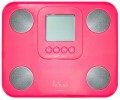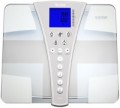Max. measurement weight
The largest weight that is allowed to be placed on the platform of this scale model. If this parameter is exceeded, the scales, at best, will not be able to show the correct data, at worst, they will completely fail. Obviously, the maximum weight is directly related to the purpose, but even kitchen scales can weigh both
up to 5 kg and up to 20 kg.
Actually, floor scales have the largest maximum measurement weight, in such models it can reach
200 kg or even more. And the most delicate are
jewelry models (refer to "Type"). Also note that in mechanical devices (refer to "Mechanism") the scale is usually graduated to the maximum weight.
Now on the market there are scales with such a maximum weight:
up to 1 kg,
up to 5 kg,
up to 10 kg,
up to 50 kg,
up to 150 kg,
up to 200 kg.
Units of measurement
Weights are able to keep records in various units of measurement, while accounting can be done both by mass and by volume. Among the most common units of measurement, we highlight the following.
— Grams (g) — a unit of weight that belongs to the metric system. Grams are used in desktop kitchen scales.
— Kilograms (kg) — a unit of weight that belongs to the metric system. Kilograms are used in floor weighing equipment.
— Pounds (lb:oz) is a common unit of weight used in some countries in Europe, as well as in the United States. 1 pound can be equated to 0.45 kilograms.
— Milliliters (ml) — a unit of volume that belongs to the metric system. Some models of scales are able to determine the volume of milk and water based on mass.
— Ounces (fl'oz) is a unit of volume used in English-speaking countries. 1 US ounce is equivalent to 30 mL.
— Stones (st) is the British unit of weight. Stones are used to take into account the mass of the human body, so this measurement system is found in floor household and specialized diagnostic scales. 1 stone can be equated to 6.35 kilograms.
Functions
—
Tare compensation. The capacity to factor in the weight of containers or packaging when weighing materials is a common feature. Typically, this function operates by placing an empty container (like a box or measuring cup) onto the scale and resetting the scale's measurement (via a button press or a specific knob turn). Consequently, when the container is filled, the scale displays only the content's weight, excluding the container's weight. Some models even allow for manual adjustment of any additional weight that shouldn't be considered.
—
Measurement of volume. The capability to measure liquid volume is a function present exclusively in kitchen scales (as outlined in "Weighing type"). It's executed through various methods. For instance, some models incorporate a divided bowl that functions as a measuring cup, operating on a similar principle. In other models, users can select the liquid type (water, milk, vegetable oil, etc.), and the scale will automatically compute the volume based on its weight. This function proves valuable when precise ingredient measurement is of utmost importance.
—
Automatic activation. Automatic activation of electronic scales when a load is placed on them. Small, but quite handy option.
—
Automatic shutdown. This function ensures that the electronic balance (see "Mechanism") turns
...off some time after the load has been removed from it. Thanks to auto-off, you can not be afraid to run out of batteries by forgetting to turn off the device. And in some models, manual shutdown is not provided at all — only automatic.
— Voice notification. Scales incorporating a voice notification feature offer audible results, typically relayed through the device's speaker. This function is commonly found in bathroom scales (as discussed in "Type of scales"), where it holds significant relevance. It caters to users who may have difficulty viewing the display without leaning or those who might find leaning inconvenient or impractical due to health issues. Voice notifications can be provided in various languages, allowing users to select their preferred language from the available options.
— Calorie calculator. This function enables the calculation of the nutritional content of weighed items, typically focusing on calorie count, although more advanced models might incorporate additional parameters like protein, fat, carbohydrates, fiber, and liquids. The scale stores information about the nutritional values of various products. When weighing, users select a specific item from this list to determine its caloric content. While theoretically useful for those meticulously monitoring their diet and calorie intake, the accuracy of the calorie calculator often provides only approximations, which may not align precisely with actual values. For instance, while the calorie calculator can accurately estimate the nutritional value of fruits and vegetables, it tends to provide general average values for grains. However, the actual calorie content of foods like porridge varies based on preparation methods. Thus, the calorie calculator should not be solely relied upon; for more precise nutritional information, consulting specialized tables and calculation methods is advisable.
— Timer. Including a timer feature in scales enables users to set countdown intervals. The user establishes a desired duration, initiates the timer, and receives a signal when the set time elapses. This functionality proves beneficial across various applications, with particular utility in the kitchen where precise time control is frequently required during cooking. Consequently, the majority of scales equipped with a timer are categorized as kitchen scales (refer to "Type of scales").
— Thermometer. Availability of the built-in thermometer in scales. Usually, this function is performed by a simple thermal sensor that determines the ambient temperature; and most scales with such equipment are kitchen scales or floor scales (refer to "Type of scales"). Note that in fact, the need for a thermometer occurs relatively rarely, and this function is more of a “nice addition” than a serious functional advantage. However, such equipment has almost no effect on the cost of scales — thermal sensors are very inexpensive.
— Synchronization with a smartphone. The capacity to link scales with a mobile device (smartphone, tablet) for data exchange is a prevalent feature. Generally, this involves installing a designated application, which might even be provided alongside the scales. The specifics of this connection and its functionalities can vary, contingent on the type and model of the scale. This feature is commonly found in floor-standing diagnostic scales, where measurement data is used to maintain a record of body information. It particularly benefits athletes, fitness enthusiasts, and individuals using physical activity for therapeutic purposes. Notably, compatibility extends beyond proprietary software to encompass third-party medical and fitness services. Another category of devices featuring synchronization capability is kitchen scales, where the accompanying application is employed for working with various culinary recipes.Memory
The number of users that can be stored in the device's memory.
Memory storage for multiple users is predominantly present in floor models of scales (as indicated in "Type of scales"), particularly those with advanced diagnostic functionalities (although the latter is not a mandatory requirement). These scales can store data for each user across multiple measurements, often including time and date stamps for each reading. Furthermore, these designs might include additional features, such as tracking changes in various parameters since the last measurement.
The choice of memory size depends on the number of users whose data needs to be stored. So, for family use, a device designed for 3 to 4 people is usually enough; less often 6 – 8 memory cells may be required. And the most "capacious" modern scales allow you to store data for 16 – 20 users; this can be useful, for example, for a sports team or a sanatorium group.
Platform / bowl material
The material from which the working surface of the scales is made is
a platform or a bowl.
—
Plastic. An economical and highly functional material applicable to all scale types is plastic. Contrary to misconceptions, plastic can exhibit impressive durability; it's even employed for manufacturing floor scale platforms that accommodate 150 kg or more. Plastic scales offer practical advantages, such as not causing discomfort from coldness against the skin—this makes stepping onto such scales, including barefoot, a comfortable experience. This attribute is particularly valuable for
children's models(refer to "Type of scales"), adding to their overall appeal.
—
Metal. The metal is highly durable and gives the device a solid appearance. On the other hand, it costs more than plastic, and the mentioned advantages in the case of scales are rarely significant. Therefore, this material is used mainly in rather expensive scales. And in low-cost models, “metal” can mean a thin metal coating applied to a plastic platform.
—
Glass. The main feature of glass surfaces can be called a stylish appearance. Glass is not without reason considered fragile, however, to break it, you need a fairly strong blow. And the strength of modern glasses is enough even for floor scales with a weight limit of more
...than 100 kg. Another advantage of this material can be called ease of cleaning.
— Wood. Wooden platforms offer a distinctive and appealing appearance, characterized by unique colors and surface patterns. This choice is particularly favored by those who appreciate natural materials and the eco-friendly style. However, wood lacks significant practical advantages over materials like plastic, and it often comes at a higher cost. Consequently, wooden scales are primarily utilized for aesthetic considerations, resulting in relatively limited availability in the market.
— Rubber. Rubber is predominantly present in two categories of scales, namely pocket and floor scales (as mentioned earlier). In pocket models, the platform pertains to the lower part of the device that comes into contact with the hand during weighing. Rubber, known for its soft and comfortable properties, is a favored material for this type of application, making it highly popular in pocket scales. Similarly, in floor scales, rubber platforms are chosen for comparable reasons. Rubber's softer texture, reduced slipperiness, and enhanced comfort when standing make it preferable to hard plastic. Additionally, rubber platforms can incorporate massage protrusions (pimples), which could be uncomfortable on rigid plastic surfaces. Despite these advantages, the higher cost of rubber makes it less prevalent compared to other materials.
In addition to those described above, modern scales can also use other materials, sometimes quite unusual — for example, marble or stone (including in the form of a mosaic with which the platform is lined), or leather (leatherette). Most often, such materials are used for aesthetic reasons.
